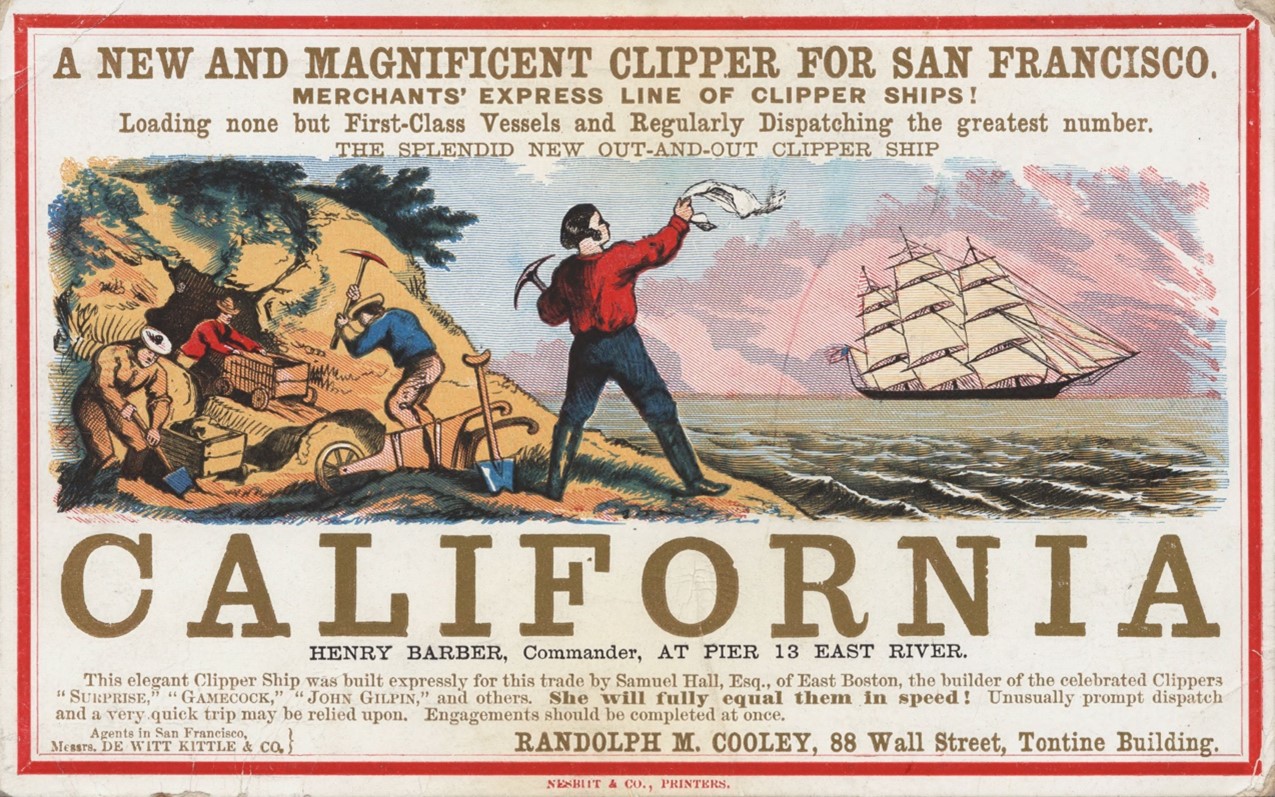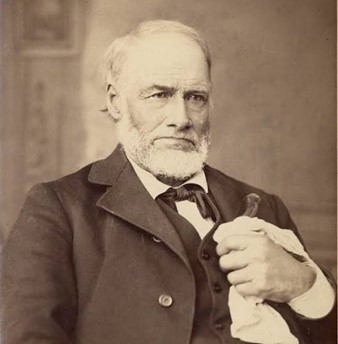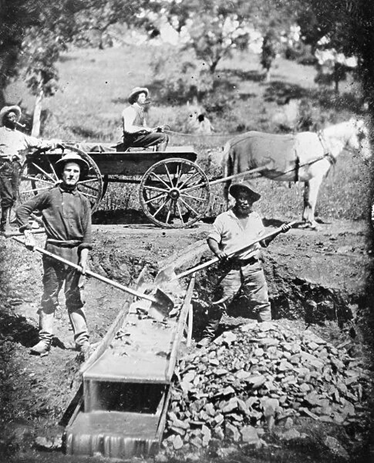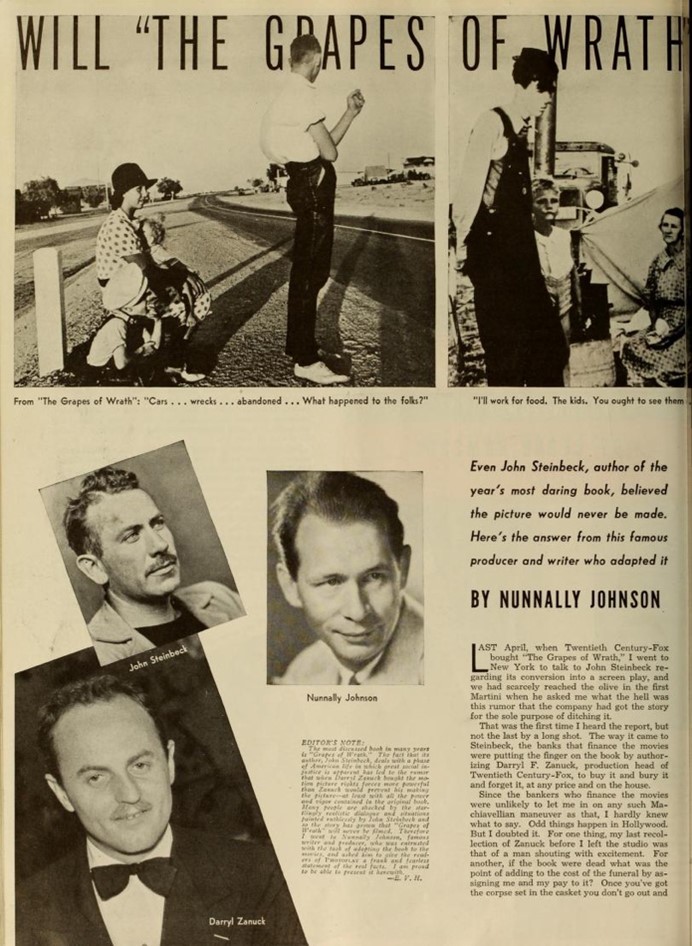Some people know the story of the Gold Rush from the Charlie Chaplin film, others from TV shows or books of all kinds. At the very least, historians consider this period to be one of the most significant of the 19th century. Both fascinating and structuring, it is particularly revealing of American society.

The gold rush is not unlike the discovery of the first coins. In the 7th century B.C., King Gyges discovered natural gold and silver alloys in the Pactolus River in what is now Turkey. This discovery brought him a gigantic fortune - hence the commonly used expression in French: "toucher le pactole", which translates to "hit the jackpot".
In January 1848, while working on a building site and digging a ditch, carpenter and laborer James Marshall discovered a gold nugget in a Californian river. Without realizing it, he had just got his hands on vast gold mines - larger than those discovered a few decades earlier in the state of Georgia. It was the beginning of the gold rush.

James Marshall
When Marshall, or rather one of his comrades Samuel Brannan, reported on this discovery, the newspapers were skeptical and downplayed the facts. But the dream soon took shape, with 11th U.S. President James K. Polk confirming the news. Numerous Americans and adventurers from all over the world (especially France, Great Britain and China) migrated to California by sea and land. The region, multicultural and booming, was enriched by thousands of men and women. Little known to Americans at the time, it doubled in size in just four years. It was the largest mass migration in U.S. history.
Independent since 1776, the country and its inhabitants proudly display this discovery. The Philadelphia North American newspaper wrote on September 14: "Your streams have minnows and ours are paved with gold." The local population felt buoyed by a divine revelation... gold being associated with spiritual brilliance in the Books. So much so that in one of the reports of the American Baptist Home Mission Society, published in 1849, it is written that this is "proof of a special plan of God by which the heathen nations of the world might be converted to Christ..." Moreover, this opportunity followed the American conquest of California a few months earlier, after their victory over Mexico in 1848.
An economic boom
In the first half of the 19th century, the United States was hit by several banking crises that destabilized the country's development. At a time when the gold standard was in force (although silver did not disappear until 1873), the discovery of these gold mines appeared to be a means of stimulating the American economy. Against the backdrop of the Industrial Revolution, raw materials and capital were flowing in, and innovation was accelerating. The new gold reserves enabled massive investment in public buildings and schools. They also contributed to the construction of one of the countless dreams of the inhabitants: a railroad across the country. Thanks to numerous migratory flows (between 1848 and 1856, nearly 300,000 people came to California), the domestic market developed and consumption increased. Towns sprouted up like mushrooms around the mines. The city of San Francisco became a major metropolis during the eight official years of the "rush", and California was named the 31st state of the United States of America. Gradually, American growth shifted from East to West.
Difficult conditions
The sense of easy enrichment made possible by the discovery of gold fascinated, then attracted. At a time when wage labor was booming, some people spent their entire savings to travel to California in search of the precious metal. But conditions there were tough. Mining requires digging up the earth and moving rocks. Housing was dilapidated, and the miners didn't have enough to eat. Many fell ill, others died or committed suicide. Some arrived too late, and most of the gold was taken after four years, with $10 million mined in 1849, $41 million in 1850, $75 million in 1851 and $81 million in 1852.
But this situation didn't just apply to California. In many parts of the United States, wages remained low, especially for workers, and working conditions were arduous. Days followed one another at the pace of the machines (which required a permanent human presence), and were repeated without days off or social protection.

Winners and losers
Few made their fortune mining gold. For many, migration to California was synonymous with disillusionment. Most wealth was amassed by those who took advantage of the general craze. The construction of hotels, railroads and other means of access to the mines multiplied. Samuel Brannan, one of the first figures of the "Gold Rush", invested heavily in real estate and became the first millionaire of the era.
The gold rush turned ideologies on their head. The American project was no longer one of wealth obtained through long labor, but of instant fortune. This short-term vision gave rise to consumerism. The lucky few who became rich by mining gold frequented the saloons of the American West, where they stocked up on poor-quality alcohol and food. Others traveled and spent their money quickly, even if it meant going broke a few years later.
In this individual quest, the researchers (many of them settlers) did not hesitate to displace and massacre the local population to maximize their profits. The Amerindian population fell from 150,000 in 1845 to 30,000 in 1870. Fierce competition between miners also set in. Americans banded together (nearly two-thirds of miners were American) and drove out foreigners. A monthly tax of around $20 was levied on non-American migrants.
Little by little, mining was no longer done by individuals, but by dedicated companies. For the new explorers, the "American dream" disappeared... Mining companies were formed and invested massively in equipment to extract gold rapidly using a new technique: hydraulic extraction. These came into being especially in the early 1860s, when available resources were steadily diminishing and required state-of-the-art equipment to be reached. Between 1860 and 1880, nearly $170 million worth of gold was extracted in this way.
California gradually becomes a world power
During the American Civil War, which broke out between 1861 and 1865, several conflicts took place around the mines. But the local population continued to grow, doubling between 1860 and 1880.
Although cohabitation between locals and migrants was difficult, particularly for Chinese migrants who suffered discrimination, the development of the railways, an agricultural economy (thanks in particular to wheat) and new innovations brought satisfaction to the inhabitants. Urbanization accelerated and access to the big cities became easier. Many got jobs. California gradually became a great place to live.
Oil, the black gold, was the next growth driver. The abundant land of the American West made the region a great success, preparing it to become a true world power.
Despite the Great Depression of 1929 and the Second World War, California managed to restructure its economy, thanks to long-term investments, particularly in real estate. The baby boom was a real lever for growth, adding to the region's cultural development (particularly Hollywood films, but also literary works by authors such as John Steinbeck, Robert Duncan and many others). Over the years, driven by high-tech companies and prestigious universities, Silicon Valley took shape and emerged as the heart of global innovation.
At the beginning of the 21st century, California continued its rapid growth thanks to an influx of capital and the development of the real estate sector. But the subprime crisis of 2007-2008 marked a turning point. Since then, the region - and the United States more generally - has steadily drifted into a slow decline, masking the onset of a future crisis that will put an end to decades of progress.

As we've seen, the gold rush was at the very heart of California's economic, demographic and cultural development.
Thanks to its abundant resources and absolute liberalism, this region - like many others in the United States - is a place where the "American dream" is allowed to flourish. But this dream, so envied by foreigners, only comes true for a tiny minority... The gold rush proved it. As humorist George Carlin so aptly put it, "It’s called the American dream because you have to be asleep to believe it."
Reproduction, in whole or in part, is authorized as long as it includes all the text hyperlinks and a link back to the original source.
The information contained in this article is for information purposes only and does not constitute investment advice or a recommendation to buy or sell.

















